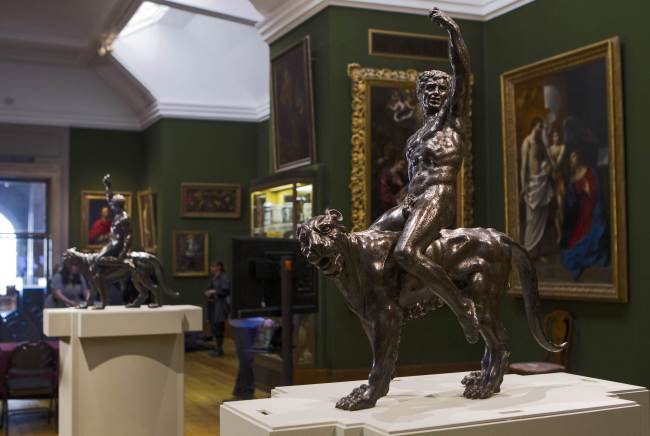LONDON, (AFP) ― The only two surviving bronzes by Italian Renaissance master Michelangelo are thought to have been identified with the help of a tiny clue in a 500-year-old sketch, British researchers said Monday.
The bronzes, “Bacchants Riding On Panthers,” date from 1506-08 and show a muscular pair of nude male revelers, arms raised in triumph to the sky, astride snarling panthers.
 |
One of two bronze statues named “Bacchants Riding on Panthers,” thought to be by Italian Renaissance master Michelangelo, displayed at the Fitzwilliam Museum in Cambridge on Feb. 2. (AFP-Yonhap) |
Michelangelo is thought to have worked on them between his two most famous works ― the four-meter marble sculpture “David” and the ceiling of the Vatican’s Sistine Chapel.
Fresh questions about who made the bronzes started to be asked after they appeared in a 2012 show at London’s Royal Academy.
Their anonymous owner called in professor Paul Joannides of Britain’s Cambridge University, for whom the sculptures triggered a memory of a sketch by one of Michelangelo’s students who had copied his master’s drawings.
That then sparked off a wave of international research involving art historians, anatomists and conservation scientists.
“In terms of Michelangelo, this is really pretty significant,” said Victoria Avery of Cambridge’s Fitzwilliam Museum, which will display the bronzes from Tuesday until August.
Cambridge University says that, if the attribution is correct, the bronzes would be the only surviving ones by Michelangelo anywhere in the world.
“Michelangelo was actually very devout in a pretty unorthodox way and I think he felt his job was to show the wonder of God’s creation and the human body in the most idealized way,” said Avery, who was involved in the research to identify them.
Experts say that only a sculptor who had practiced dissection, as Michelangelo had, would be able to create such anatomically correct bronzes.
The sculptures are similar in style to others by him dating from 1500 to 1510, while neuron x-ray imaging also suggests the sculptures date from the late 15th or early 16th century.
Michelangelo often drew inspiration from ancient mythology for his works.
Bacchants were followers of Bacchus, the Roman god of wine and fertility, who pursued the instinctive, sensual life.
“The poses, they’re kind of outrageous. Nude men astride panthers, what’s all that about?” Avery said.
History of misattribution
While Michelangelo’s marble sculptures such as “David” are famous worldwide, researchers say it is a common misconception that he never worked in bronze.
Records show that Michelangelo made bronzes including a two-thirds size “David” for a French aristocrat and a twice life-size statue of Pope Julius II.
However, the first disappeared during the French Revolution while the second was melted down and the bronze used for artillery three years after it was made.
The “Bacchants Riding on Panthers” were previously attributed to Michelangelo during the 19th century when they were owned by Baron Adolphe de Rothschild of the famous French banking dynasty.
In the 20th century, experts believed they had been made by a range of artists, including followers of Benvenuto Cellini.
The definitive conclusions of the research into their provenance will be presented at a conference in July.








![[Weekender] Korea's traditional sauce culture gains global recognition](http://res.heraldm.com/phpwas/restmb_idxmake.php?idx=644&simg=/content/image/2024/11/21/20241121050153_0.jpg)